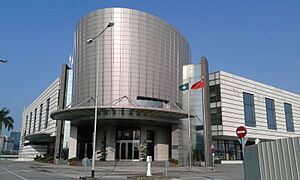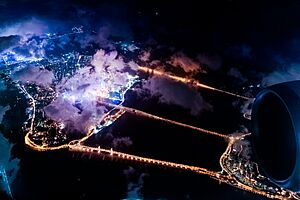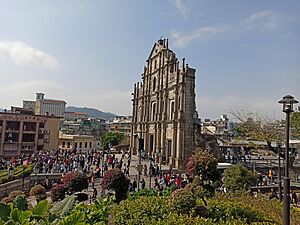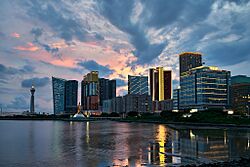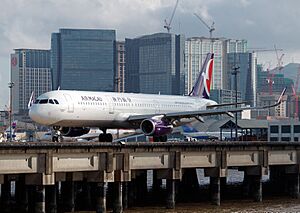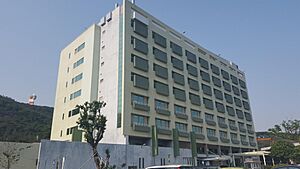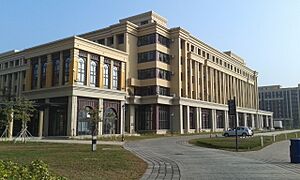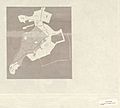Macau facts for kids
Quick facts for kids
Macau
澳門
|
|||||||
|---|---|---|---|---|---|---|---|
|
Special administrative region
|
|||||||
| Macao Special Administrative Region of the People's Republic of China
Other official names
|
|||||||
|
|||||||
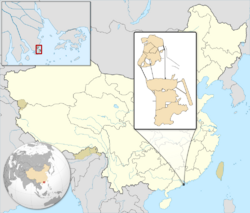
Location of Macau within China
|
|||||||
| Sovereign state | China | ||||||
| Portuguese lease | 1557 | ||||||
| Treaty of Peking | 1 December 1887 | ||||||
| Sino-Portuguese Joint Declaration | 26 March 1987 | ||||||
| Handover of Macau | 20 December 1999 | ||||||
| Largest parish by population |
Nossa Senhora de Fátima | ||||||
| Official languages |
|
||||||
|
|||||||
|
Official scripts
|
|
||||||
| Ethnic groups
(2016)
|
88.4% Han Chinese 4.6% Filipino 2.4% Vietnamese 1.7% Portuguese 2.8% other |
||||||
| Demonym(s) | Macau | ||||||
| Government | Devolved executive-led government within a unitary one-party state | ||||||
| Sam Hou Fai | |||||||
|
• Administration and Justice Secretary
|
André Cheong Weng Chon | ||||||
|
• Assembly President
|
Kou Hoi In | ||||||
|
• Court President
|
Song Man Lei | ||||||
| Legislature | Legislative Assembly | ||||||
| Area | |||||||
|
• Total
|
115.3 km2 (44.5 sq mi) | ||||||
|
• Water (%)
|
73.7 | ||||||
| Highest elevation
(Alto de Coloane)
|
172.4 m (565.6 ft) | ||||||
| Population | |||||||
|
• 2024 estimate
|
712,651 | ||||||
|
• Density
|
20,300/km2 (52,576.8/sq mi) (1st) | ||||||
| GDP (PPP) | 2024 estimate | ||||||
|
• Total
|
|||||||
|
• Per capita
|
|||||||
| GDP (nominal) | 2024 estimate | ||||||
|
• Total
|
|||||||
|
• Per capita
|
|||||||
| Gini (2018) | 36.0 medium |
||||||
| HDI (2022) | very high · 24th |
||||||
| Currency | Macanese pataca (MOP) | ||||||
| Time zone | UTC+08:00 (Macau Standard Time) | ||||||
| Date format | dd/mm/yyyy yyyy年mm月dd日 |
||||||
| Mains electricity | 220 V–50 Hz | ||||||
| Driving side | left | ||||||
| Calling code | +853 | ||||||
| ISO 3166 code |
|
||||||
| Internet TLD | |||||||
| Licence plate prefixes | None for local vehicles, 粤Z for cross-boundary vehicles | ||||||
Macau or Macao is a special region in China. It's officially called the Macao Special Administrative Region of the People's Republic of China. Macau is a very small place, but it has a lot of people! It's the most densely populated region in the world.
Macau used to be a Portuguese colony. This means Portugal ruled it for a long time. It was first leased to Portugal by the Ming dynasty in 1557 as a trading spot. Portugal paid rent and managed the area under Chinese rule until 1887. Later, Portugal gained full colonial rights. Macau stayed under Portuguese rule until 1999, when it was given back to China.
Today, Macau is a special administrative region of China. It has its own government and economic systems, separate from mainland China. This is part of the "one country, two systems" idea. The city's mix of Portuguese and Chinese buildings is so unique that its historic center became a UNESCO World Heritage Site in 2005.
Macau was once a quiet group of islands. But since the late 1900s, it has become a huge resort city. It's famous for its gambling tourism, often called the "Las Vegas of the East." Its gambling industry is much bigger than Las Vegas. Macau also has one of the highest incomes per person in the world. It also has a very high Human Development Index and one of the highest life expectancies. Most of Macau's land has been built on, with new areas created from the sea.
What's in a Name?
The name "Macau" first appeared in writing in 1555. Locals believed the sea goddess Matsu (also called A-Ma) protected their harbor. They called the waters near her temple "A Ma Gang." When Portuguese explorers arrived, they asked for the place name. The locals thought they were asking about the temple and said "Ma Kok." The Portuguese first spelled it Amaquão. Over time, spellings like Amacão and Macão became common.
The spelling Macau became standard in Portuguese in 1911. But in English and other European languages, Macao is still often used.
Macau Peninsula had many Chinese names, like Jing'ao and Haojing. The islands of Taipa, Coloane, and Hengqin were called Shizimen. Later, the name Ou mún (meaning "bay gate" or "port gate") was used for the whole area.
Macau's Past
Early History
During the Qin dynasty (221–206 BC), Macau was part of Guangdong province. People first settled here during the Han dynasty. In 1152, during the Song dynasty, it became part of Xiangshan County. In 1277, about 50,000 people came to the coast, escaping the Mongol conquest of China.
Portuguese Arrival
The first European to reach China by sea was Jorge Álvares in 1513. Portuguese merchants set up a trading post in Hong Kong waters. But there were fights between the Ming Chinese and Portuguese navies. The Portuguese were forced out in 1521. They kept trying to settle in other parts of the Pearl River estuary and finally settled in Macau.
The Portuguese lost some battles when they tried to take trading posts by force. But they later returned peacefully. In 1554, they made a deal with China. They rented Macau as a trading post, paying rent each year. In 1557, Portugal got a permanent lease for Macau. They agreed to pay 500 silver coins annually.
A Busy Trading Hub
Macau became an important stop for ships traveling between Japan and the rest of the world. It was a major storage place for goods in the late 1500s. It helped export Chinese silk to Japan. The Roman Catholic Diocese of Macau was created in 1576. By 1583, a local council was set up to manage the growing settlement.
The Portuguese were not allowed to build forts or store weapons at first. But they built the Fortaleza do Monte because the Dutch often attacked by sea. The Dutch tried to take the city in 1622 but were stopped by the Portuguese. Macau's trade declined in the 1640s. Japan stopped trade in 1639, and the Dutch took Portuguese Malacca in 1641.
Later Colonial Rule
China banned sea trade in 1644. This was after the Qing dynasty took over. Trade was only allowed in Macau, and on a smaller scale. The Qing authorities had more control over Macau during this time. Foreign ships had to stop at Macau before going to Canton. As trade in certain goods grew, Macau became an important stop again.
After the First Opium War and the British setting up Hong Kong, Macau lost its role as a main port. Industries like firecracker and incense making, and tea processing, became important. Portugal used China's weakness to claim more control. The Governor of Macau stopped paying rent in the 1840s. Portugal also took over Taipa and Coloane islands. In 1887, Portugal's right to occupy Macau forever was made official. This agreement also said Portugal could not give Macau away without China's approval.
World Wars and Handover
During World War II, Japan did not occupy Macau. They mostly respected Portugal's neutral position. However, in 1943, Japan put government "advisors" in Macau. In 1945, the United States bombed Macau. This was because they learned the colonial government might sell airplane fuel to Japan.
Many refugees from mainland China came to Macau during the Chinese Civil War. This large workforce helped Macau's economy grow. The colony expanded its clothing industry and tourism. Casino gaming was also made legal. In 1966, there were riots in Macau. Portugal lost some control and agreed to work with the Chinese Communist Party.
After 1974, Portugal officially gave up Macau as an overseas province. They called it a "Chinese territory under Portuguese administration." China and Portugal started talks about Macau in 1986. They signed an agreement in 1987. Portugal agreed to hand over Macau in 1999. China promised Macau's political and economic systems would stay the same for 50 years. Macau built new airports and ports before the handover. The handover happened on December 20, 1999, after 442 years of Portuguese rule.
After the handover, Macau allowed more companies to run casinos. This led to a new period of economic growth. Macau's economy grew very fast from 2002 to 2014. This made Macau one of the richest places in the world per person.
How Macau is Governed
Macau is a special administrative region of China. It has its own executive, law-making, and court powers. These powers come from the national government of China. The agreement between China and Portugal made sure Macau's economy and government would continue as before. This is part of the "one country, two systems" idea. Macau's government is very similar to Hong Kong's.
Macau's government has three main parts:
- Executive: The Chief Executive makes sure laws are followed. They can ask for laws to be looked at again. They also choose members for the Executive Council and some lawmakers.
- Legislature: The Legislative Assembly makes laws and approves budgets. It can also remove the Chief Executive from office.
- Judiciary: The Court of Final Appeal and other courts explain laws. They can also cancel laws that don't fit with Macau's Basic Law. Judges are chosen by the Chief Executive.
The Chief Executive is the head of the government. They serve for a maximum of two five-year terms. China's State Council appoints the Chief Executive.
The Legislative Assembly has 33 members. They serve for four years. Some are chosen directly by people, some indirectly by groups, and some are appointed by the Chief Executive.
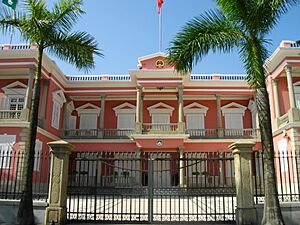
Chinese national laws generally do not apply in Macau. Macau has its own legal system based on Portuguese civil law. This continues the legal traditions from when Portugal ruled. Macau's courts are connected to China's legal system.
Macau's separate system is clear in its immigration and tax rules. Macau issues its own passports to residents. It has a controlled border with mainland China. Everyone traveling between Macau, China, and Hong Kong must go through border checks. Macau also handles its own money and taxes. Taxes collected in Macau do not go to the central Chinese government.
The Macao Garrison is in charge of Macau's defense. The regional government can ask for help from the garrison if needed. Macau residents do not have to do military service.
Macau's Divisions
Macau is divided into seven areas called parishes. Some newer areas, like Cotai and parts of the Macau New Urban Zone, don't have parishes yet. In the past, these parishes belonged to two larger areas that managed local services. These larger areas were removed in 2001. Now, the Civic and Municipal Affairs Bureau provides local services.
| Parish/Area | Chinese Name | Area (km2) |
|---|---|---|
| Parishes | ||
| Nossa Senhora de Fátima | 花地瑪堂區 | 3.2 |
| Santo António | 花王堂區 | 1.1 |
| São Lázaro | 望德堂區 | 0.6 |
| São Lourenço | 風順堂區 | 1.0 |
| Sé | 大堂區 | 3.4 |
| Nossa Senhora do Carmo | 嘉模堂區 | 7.9 |
| São Francisco Xavier | 聖方濟各堂區 | 7.6 |
| Other Areas | ||
| Cotai | 路氹填海區 | 6.0 |
| New District Zone A | 新城A區 | 1.4 |
| HZMB Zhuhai-Macau Port | 港珠澳大橋珠澳口岸 | 0.7 |
| University of Macau (Hengqin campus) | 澳門大學 (橫琴校區) | 1.0 |
Macau's Geography
Macau is on China's southern coast. It's about 60 kilometers (37 miles) west of Hong Kong. It sits on the western side of the Pearl River estuary. The South China Sea surrounds Macau to the east and south. The city of Zhuhai in Guangdong is to its west and north.
Macau includes the Macau Peninsula, Taipa, and Coloane islands. A small piece of land on Hengqin island, where the University of Macau is, also belongs to Macau. The highest point in Macau is Coloane Alto, which is 170.6 meters (560 feet) above sea level.
Most people live on the Macau Peninsula. This area was once a separate island. Over time, sand built up, connecting it to the mainland. Both natural processes and land reclamation (creating new land from the sea) have made Macau much larger. Macau has tripled its land area in the last 100 years. It grew from 10.28 square kilometers (3.97 sq mi) in the late 1800s to 32.9 square kilometers (12.7 sq mi) in 2018.
Cotai is a reclaimed area connecting Taipa and Coloane. Many new casinos and resorts are there. In 2015, Macau gained control over a much larger area of the sea around it. More land is being created for the Macau New Urban Zone. Macau also controls part of an artificial island for a border checkpoint for the Hong Kong–Zhuhai–Macau Bridge.
Climate and Weather
Macau has a humid subtropical climate. This means it has hot, humid summers and mild, dry winters. Summer (May to September) and winter (December to February) are the longest seasons. Spring (March and April) and autumn (October and November) are short.
The summer monsoon brings warm, humid air from the sea. This is when Macau gets the most rain. Typhoons also happen often in summer, bringing heavy rainfall. In winter, dry winds from the north bring much less rain. The highest temperature ever recorded was 38.9 °C (102.0 °F). The lowest was -1.8 °C (28.8 °F).
People of Macau

At the end of 2018, Macau had about 667,400 people. It is the most densely populated place in the world. Most people (88.7%) are Chinese. Many come from Guangdong or Fujian provinces. The rest (11.6%) are other groups, mainly Filipinos, Vietnamese, and Portuguese. Some residents are Macanese, who have mixed Portuguese and Asian heritage. About half of the people living in Macau were born there.
The main language is Cantonese. About 87.5% of people speak it. Only a small number (2.3%) speak Portuguese, which is the other official language. More people from mainland China have moved to Macau. This has increased the number of Mandarin speakers. About half of the population (50.4%) can speak Mandarin. Traditional Chinese characters are used for writing, not the simplified characters used in mainland China. English is also used and spoken by over a quarter of the population.
Religion in Macau (2012) Buddhism (incl. Chinese folk religion) (80%) Christianity (6.7%) Other (13.7%)
Most people in Macau (80%) practice Buddhism. About 6.7% follow Christianity. Other religions make up 13.7%. Traditional folk practices are also common.
People in Macau live a long time. In 2018, life expectancy was 81.6 years for males and 87.7 years for females. This is one of the highest in the world. Most government healthcare is free.
Many people who work in Macau are from other countries. They make up over 25% of the workforce. They often work in jobs like construction, hotels, and restaurants.
Macau's Economy
Macau has a capitalist economy. It mainly relies on casino gaming and tourism. It is the world's 83rd-largest economy. The income per person was about US$69,430 in 2023. Macau has a high income per person, but also a big gap between rich and poor.
Macau's gambling industry is the biggest in the world. It makes billions of dollars in revenue. This is about seven times more than Las Vegas. Taxes from gambling help fund a good welfare system. They also provide an annual cash payment to Macau's citizens.
The economy depends a lot on casino gaming. Most government money (79.6% of tax revenue) comes from gambling. Local taxes on personal income and sales are very low. Gambling made up over 60% of Macau's economy in 2013. It still accounts for 49.1% of all economic output. Most casino visitors are tourists from mainland China. Gambling is illegal in mainland China and Hong Kong. This gives Macau a special position in the industry.
Casino gambling became legal in 1962. At first, only one company had the right to run casinos. In 2002, the government allowed other companies to open casinos. This brought in foreign investors. It also became easier for Chinese visitors to travel to Macau. This led to a period of fast economic growth. From 1999 to 2016, Macau's economy grew seven times larger. The unemployment rate also dropped a lot. Many famous casinos opened after 2002. Casinos employ about 24% of all workers in Macau.
Manufacturing used to be a much bigger part of Macau's economy. But it has shrunk a lot. Now, Macau's economy relies almost entirely on gambling. The government is trying to make the economy more diverse.
The government traditionally did not interfere much with the economy. Taxes on companies were very low. But after the handover, the government became more involved in social welfare. This helps balance the ups and downs of the gambling industry. China's central government also helps guide casino growth. It controls how many tourists visit Macau. Macau and mainland China have a free trade agreement. This removes barriers to trade and investment.
Because Macau is small, it doesn't have much land for farming. Almost all food and foreign goods are imported. They often come through Hong Kong.
Buildings and Travel
Getting Around Macau
Macau has a well-developed road system. It has over 400 kilometers (250 miles) of roads. Cars drive on the left side of the road, just like in Hong Kong. Traffic can be very busy, especially in the older parts of the city. Public buses run over 80 routes. There are also free hotel shuttle buses to popular tourist spots. About 1,500 black taxis operate in Macau.
The Hong Kong–Zhuhai–Macau Bridge opened in 2018. It connects Macau directly to the eastern side of the Pearl River estuary. You can also cross into mainland China at border checkpoints.
Macau International Airport serves over 8 million passengers each year. It is the main airport for Air Macau. Ferry services to Hong Kong and mainland China run from ferry terminals. You can also take a helicopter to Hong Kong and Shenzhen. Macau's first train system, the Macau Light Rapid Transit, started in December 2019. The Taipa line connects 11 stations in Taipa and Cotai.
Healthcare in Macau
Macau has one main public hospital, the Hospital Conde S. Januário. It also has a major private hospital, the Kiang Wu Hospital. Both are on the Macau Peninsula. There's also the Macau University of Science and Technology Hospital in Cotai. Macau has many health centers that offer free basic medical care to residents. You can also get traditional Chinese medicine.
The Fire Services Bureau provides ambulance services. The Macau Red Cross also runs ambulances with volunteer staff. The Health Bureau in Macau helps coordinate public and private health services. It works to keep citizens healthy and prevent diseases. The Macau Centre for Disease Control and Prevention was set up in 2001. It watches over hospitals and health centers.
Sometimes, if Macau hospitals can't handle a case, patients are sent to Queen Mary Hospital in Hong Kong. Many Macau residents also choose to get healthcare in Hong Kong.
Learning in Macau
Education in Macau doesn't have one single set of rules. Different schools follow different systems. These include Chinese, Portuguese, Hong Kong, and British styles. Children must go to school from age five until they finish lower secondary school, or until age 15. Most adults in Macau have finished lower secondary education. Many have also graduated from high school or earned a university degree. This mandatory education helps Macau have a high literacy rate of 96.5%.
Most schools in Macau are private. Out of 77 non-university schools, only 10 are public. The Roman Catholic Diocese of Macau runs 27 primary and secondary schools. The government provides 15 years of free education for students in public schools. It also helps pay for tuition in private schools.
Most schools use Cantonese as the main teaching language. They teach in written Chinese and have required Mandarin classes. Some private schools use English or Portuguese. Portuguese-Chinese schools mainly use Chinese but also require Portuguese classes.
Macau has ten universities and higher education institutes. The University of Macau, founded in 1981, is the only public university. The Kiang Wu Nursing College of Macau is the oldest. It trains nurses for its hospital. Other universities include the University of Saint Joseph and the Macau University of Science and Technology.
Macau's Culture
Macau's culture is a special mix of Chinese and Portuguese traditions. This has been happening for over 400 years. The biggest event each year is the Macau Grand Prix in November. The main streets of Macau Peninsula become a race track, similar to the Monaco Grand Prix. Other yearly events include the Macau Arts festival in March and the International Fireworks Display Contest in September.
The Lunar Chinese New Year is the most important traditional festival. It usually happens in late January or early February. The A-Ma Temple is very busy in April for the A-Ma festival. In May, you might see dancing dragons for the Feast of the Drunken Dragon. The Dragon Boat Festival takes place on Nam Van Lake in June.
Macau has many historic buildings. Its historic center has about twenty-five historic spots. UNESCO listed it as a World Heritage Site in 2005. However, some people worry that new building projects might harm Macau's historic sites.
Delicious Food
Food in Macau is a mix of Cantonese and Portuguese cuisine. It also has influences from Indian and Malay dishes. This unique blend comes from centuries of Portuguese rule. Portuguese recipes were changed to use local ingredients. These include fresh seafood, turmeric, and coconut milk. This created Macanese versions of Portuguese dishes.
Many restaurants offer a mix of Cantonese-Portuguese food. Galinha à portuguesa is a Chinese dish with Macanese influences. Cha chaan teng diners, which serve Hong Kong-style Western food, are also common. Popular street foods include pastel de nata (egg tarts), pork chop buns, and almond biscuits.
Sports in Macau
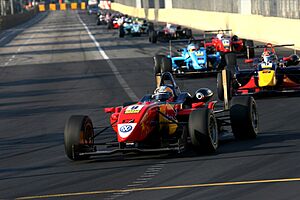
Even though Macau is small, it has many sports facilities. It has hosted major international sports events. These include the 2005 East Asian Games and the 2006 Lusophony Games.
Macau regularly hosts the Macau Grand Prix. This is a big annual motorsport race. City streets are used as the racetrack. It's the only street circuit that hosts Formula Three, touring car, and motorcycle races at the same event. The Guia Circuit is known for its narrow corners and winding path. It's considered a very challenging course for racers.
Macau has its own sports teams in international competitions. It has its own National Olympic Committee. However, it does not compete in the Olympic Games. This is because new Olympic committees can only be admitted if they represent independent countries.
Images for kids
-
"Macau" in Traditional (top) and Simplified (bottom) Chinese characters
See also
 In Spanish: Macao para niños
In Spanish: Macao para niños
- Foreign relations of Macau
- Outline of Macau
- Index of Macau-related articles
- Cuiheng New Area






